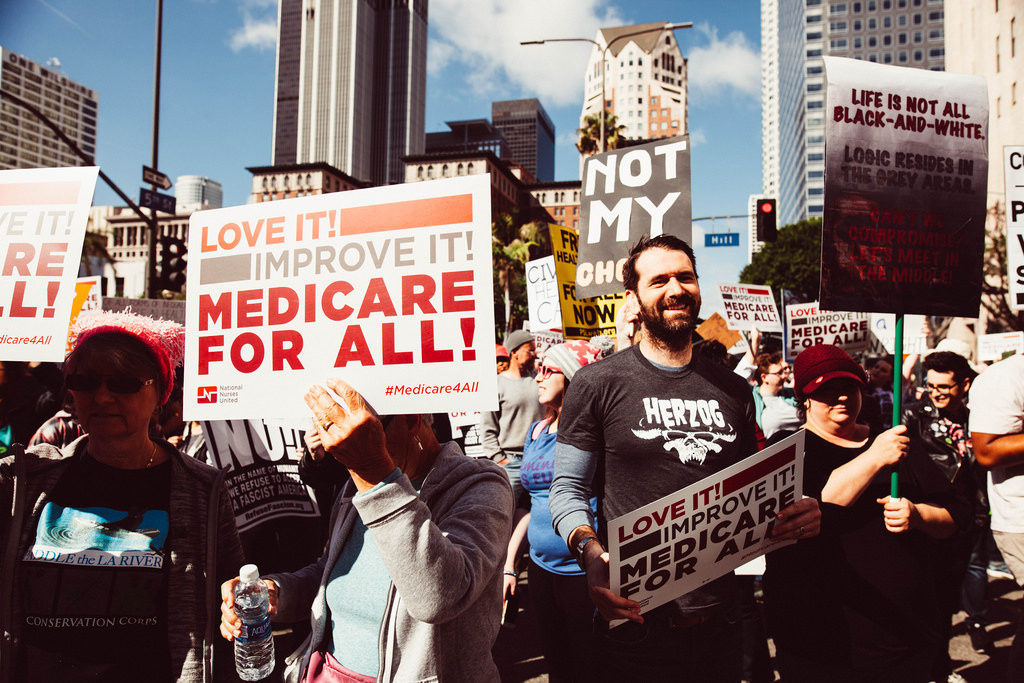The American health care system, unlike what many Republicans and some Democrats would say, is not the best health care system by a longshot. We should be honest with Americans about the reason for our dysfunctional healthcare system and the disparaging of single-payer Medicare for All.
Last week we stated that “We should be out in the streets over health insurance now.” — the reason?
We are currently spending an inordinate amount of time on issues that relate mostly to the corrosively corruptive nature of the Trump administration. From Russia to Cohen to Stormy Daniels to Pruitt among corruption and swamp dwellers, these topics continue to consume cable news, broadcast news and much in the print news. We cannot allow these critical issues to take our eyes off of the ball.
Come October, the issue that is getting marginal notice by the media will explode. America will get their new Affordable Care Act options in October, and it will not be pretty. And for those who have employer-based insurance who think they are immune to the expected inflated health insurance prices, think again.
While the immediate concern is the decimation and sabotage of the Affordable Care Act, long term we need to be on the streets to demand the only mathematically sound and moral health care system which is a nonprofit single-payer Medicare for All system. For decades Americans have been asked to disregard math and common sense. The powers-that-be told Americans that the market is the solution for just about everything. That is false.
In the case of healthcare, the socialized delivery of healthcare is the only efficient option that allows delivery to all. We must also have a highly regulated private sector that helps innovation along with the public sector to develop drugs, medical products, and medical devices. Additionally, it is imperative that the country subsidizes education for medical workers (doctors, nurses, etc.) to ensure medical professionals are more concerned about healing patients as opposed to overbilling because of the boat anchor that is student loans.
The single-payer case is straightforward to make. It does not take rocket science to pay a bill. If a doctor’s office or hospital have one entity to send a bill to, then the inefficiency of excessive staff is eliminated.
Medicare for All is a no-brainer. Medicare is currently a virtual single-payer system that covers the elderly. Scaling it to include the entire country would not be difficult.
The purpose of healthcare is to heal. The goal of private business is to make a profit. There is absolutely nothing wrong with that. However, companies maximize earnings by providing more services and products. These two realities explain a medical culture of over-testing under the pretense of protecting against lawsuits as well as the overprescription of drugs partially responsible for the opioid epidemic and much more. It is a clear proof that medicine belongs outside of the capitalist market as examined in the article ‘” Is curing patients a sustainable business model?” Goldman Sachs analysts ask.’
One-shot cures for diseases are not great for business—more specifically, they’re bad for longterm profits—Goldman Sachs analysts noted in an April 10 report for biotech clients, first reported by CNBC.
The investment banks’ report, titled “The Genome Revolution,” asks clients the touchy question: “Is curing patients a sustainable business model?” The answer may be “no,” according to follow-up information provided.
Analyst Salveen Richter and colleagues laid it out: “The potential to deliver “one-shot cures” is one of the most attractive aspects of gene therapy, genetically engineered cell therapy, and gene editing. However, such treatments offer a very different outlook with regard to recurring revenue versus chronic therapies… While this proposition carries tremendous value for patients and society, it could represent a challenge for genome medicine developers looking for sustained cash flow.”
For a real-world example, they pointed to Gilead Sciences, which markets treatments for hepatitis C that have cure rates exceeding 90 percent. In 2015, the company’s hepatitis C treatment sales peaked at $12.5 billion. But as more people were cured and there were fewer infected individuals to spread the disease, sales began to languish. Goldman Sachs analysts estimate that the treatments will bring in less than $4 billion this year.
The bottom line is that in healthcare, profit becomes an expense. It depends on people being sick. That is both mathematically and morally dubious. It is unsustainable and cannot stand. Single-payer Medicare for all is disparaged because when the realities come out, it is clearly superior.
We can make the change to a nonprofit single-payer Medicare for All abruptly or incrementally. There are pitfalls to each. The abrupt method would cause much disruption that could raise the ire of the population if not properly managed. An incremental change runs the risk of sabotaging it right back to a dysfunctional state.The Affordable Care Act for all practical purposes was a gradual change to our healthcare system, and Donald Trump and his cabal are killing it by a thousand cuts.

